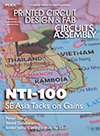News
ENDICOTT, NY – The U.S. Department of Defense has awarded Endicott Interconnect Technologies multiple contracts totaling $164 million to produce card frame assemblies, including organic semiconductor packaging, module assemblies, printed circuit boards and assemblies, and engineering services. The company did not specify what product the assemblies would be used for. EI recommended its HyperBGA organic substrate as an alternative to ceramic semiconductor packages, leading to the module assembly business and the initial $6.5 million award. Subsequent development and collaboration lead to additional technical scope for follow-on contracts, including PCB fabrication, complex board assembly and higher level integration into card frame subsystems. Contracts totaling $37.5 million product certification, which included build of the formal qualification parts and all related documentation, reporting, quality and reliability requirements. The remaining $120 million contract was awarded for the first production order of fully integrated card frame assemblies, to be delivered by year-end.
LEXINGTON, KY – EMS provider SMC today announced plans to add 18,000 sq. ft. to their current 55,000 sq. ft. facility in Lexington. The added capacity will include 16,000 sq. ft. of manufacturing space and 2,000 sq. ft. of office space. In 2005, SMC completed an expansion of 18,000 sq. ft. of manufacturing space at the same location.
ATLANTA - Technology Forecasters Inc. and Circuits Assembly will sponsor a Webinar, Emerging Markets for Electronic Manufacturers: A Closer Look at India and Vietnam, on April 12.
PORTLAND, OR – Intel Corp. invites suppliers to participate in a technology interchange in which the semiconductor company will share its vision and reveal its requirements for the supply chain. The event – Where Are We Going? Where Do We Need to Be? – will be held May 23 at the Holiday Inn Portland Airport.
Intel general manager of systems manufacturing technology development Martin Rausch will keynote the event, speaking on The Inevitable Transition to HDI.
Other topics to be discussed include underlying issues that must be overcome as the industry makes advances in package scaling and associated board density, and what needs to happen to create pull for HDI PCBs from the OEM and ODM communities.
Nine industry suppliers will outline the supply chain's abilities and present gap analyses in the areas of lamination, cost-effective microvias, metallization/etching, embedded passives, board-level underfill solutions, component size and spacing reductions, assembly equipment, rework and alternative alloys.
For more information, contact Susan Filz, SusanFilz@ipc.org.
Registration form:
http://www.ipc.org/3.0_Industry/3.5_Councils_Associations/3.5.0_IPC/3.5.0.1_Suppliers/intel-0507/intel0507-REG.pdf
Intel general manager of systems manufacturing technology development Martin Rausch will keynote the event, speaking on The Inevitable Transition to HDI.
Other topics to be discussed include underlying issues that must be overcome as the industry makes advances in package scaling and associated board density, and what needs to happen to create pull for HDI PCBs from the OEM and ODM communities.
Nine industry suppliers will outline the supply chain's abilities and present gap analyses in the areas of lamination, cost-effective microvias, metallization/etching, embedded passives, board-level underfill solutions, component size and spacing reductions, assembly equipment, rework and alternative alloys.
For more information, contact Susan Filz, SusanFilz@ipc.org.
Registration form:
http://www.ipc.org/3.0_Industry/3.5_Councils_Associations/3.5.0_IPC/3.5.0.1_Suppliers/intel-0507/intel0507-REG.pdf
TAIPEI -- Chi Mei Optoelectronics, Taiwan's second largest LCD
maker, and Hon Hai announced plans to form a TV component
joint venture
A Chi Mei spokeswoman said each company will contribute $14 million toward the new JV.
Hon Hai is the parent company of Foxconn, the world's largest EMS/ODM company.
A Chi Mei spokeswoman said each company will contribute $14 million toward the new JV.
Hon Hai is the parent company of Foxconn, the world's largest EMS/ODM company.
ALBUQUERQUE, NM – Delta Group Electronics has purchased the assets of Sanford, FL-based electronics manufacturing services supplier Singletec Inc. No financial terms were disclosed.
Press Releases
- Innominds and SIIX launch SIIX-Innominds JV to offer full-stack ODM services in India
- Syrma SGS Technology, Ltd to Accelerate AI-Driven Manufacturing with implementation of analytics and AI solution from Arch Systems in partnership with NMTronics India
- TTCI and The Training Connection Strengthen Electronics Manufacturing with Test Services and Training at PCB West 2025
- SMTA “Members of Distinction” Awards Announced


